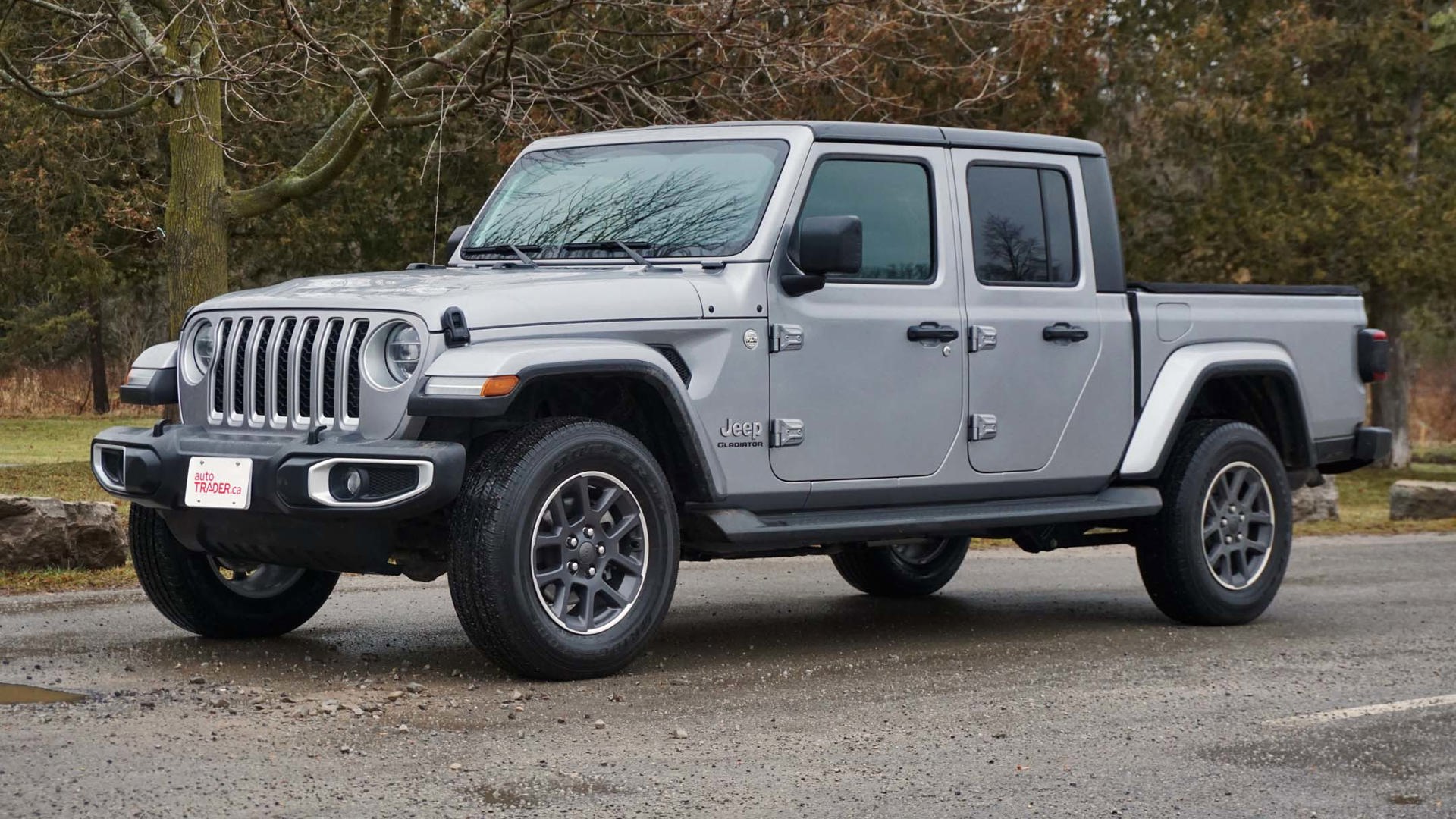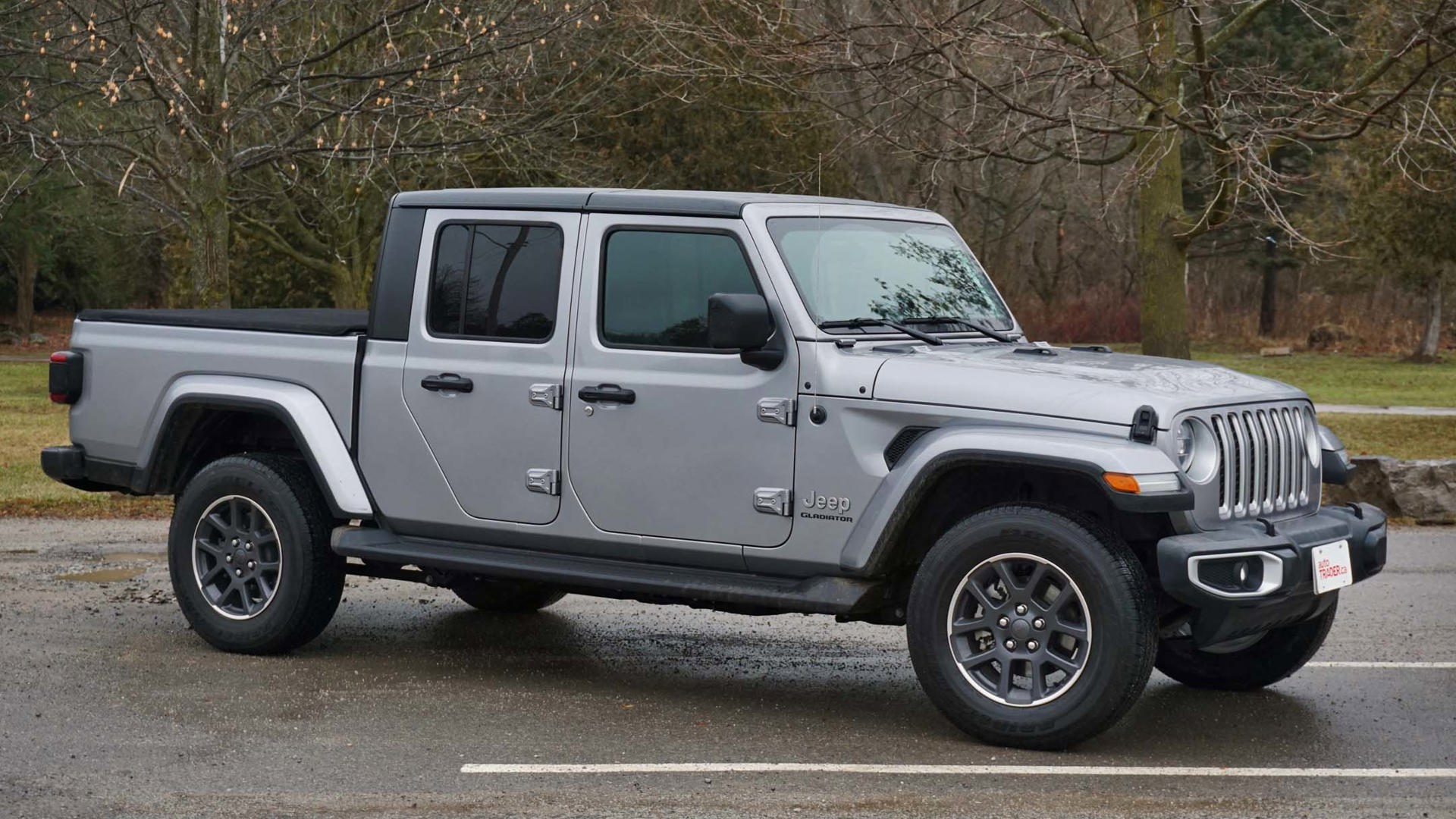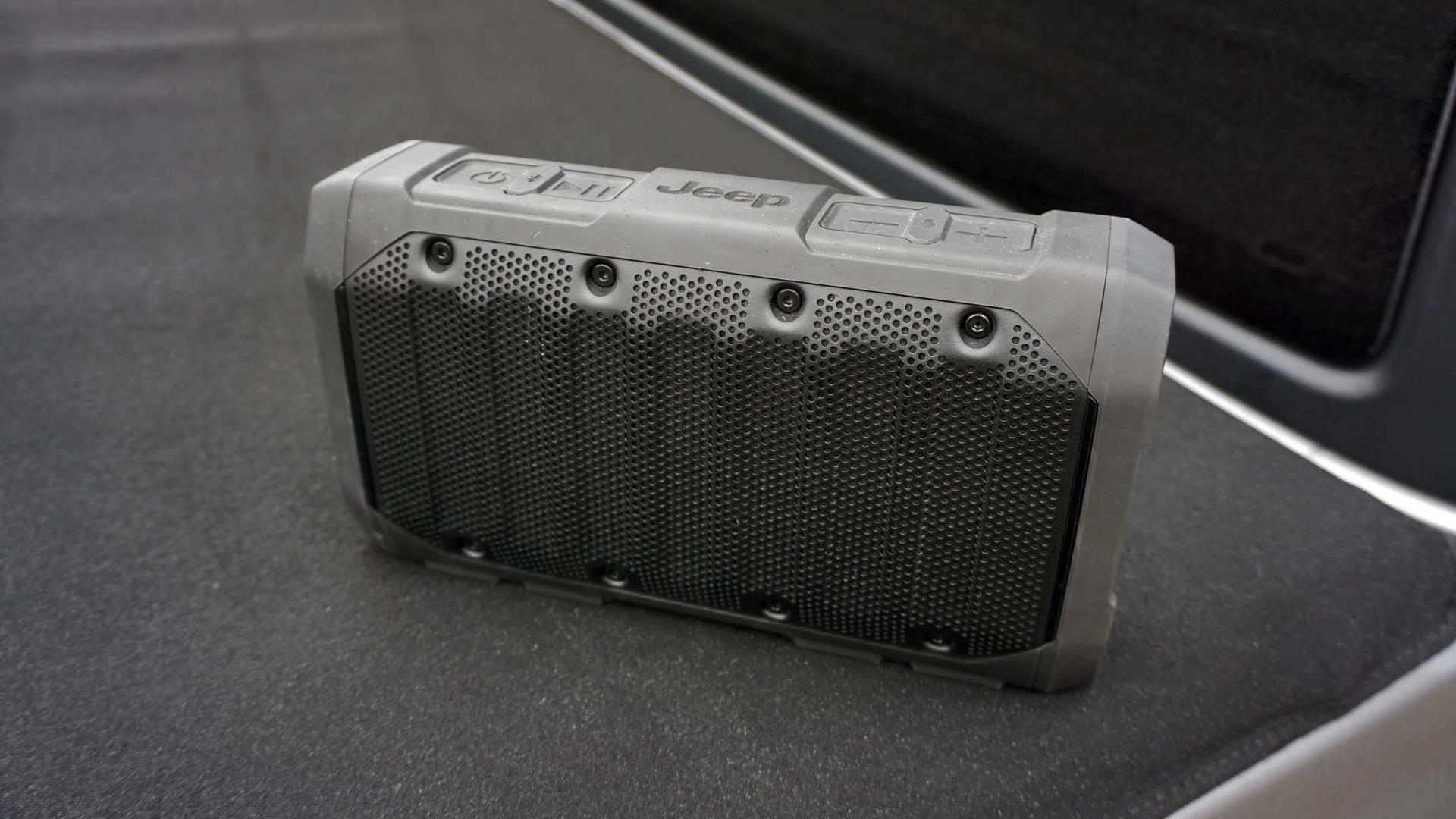 AutoTrader SCORE
AutoTrader SCORE
-
STYLING9/10
-
Safety7/10
-
PRACTICALITY8/10
-
USER-FRIENDLINESS8/10
-
FEATURES7/10
-
POWER8/10
-
COMFORT8/10
-
DRIVING FEEL7/10
-
FUEL ECONOMY6/10
-
VALUE6/10
Let’s be real: Most of the fine folks perusing the countless pages of the autoTRADER.ca marketplace looking at pickup trucks probably don’t actually need one.
Maybe you’re one of them – and there’s nothing wrong with that. These days, they’re lifestyle vehicles more than anything else and make fewer compromises than ever before. And in that way, the 2020 Jeep Gladiator may be the perfect pickup truck.
Value: 6/10
Perfect except for the price, that is. It’s not often an autoTRADER.ca review starts by examining a vehicle’s value, but there’s some serious sticker shock here. Looking to get in on the ground level? Be prepared to plunk down a cool $47,245 before freight and fees. And that’s for a base model with a manual transmission and a soft top. By comparison, the priciest trim the Chevrolet Colorado is offered in, the off-road-ready ZR2, will set you back just $345 more before any extras, ringing in at $47,600.
Want to add stuff to your Gladiator to make it feel like it’s up to modern standards? They don’t come cheap. Heated seats and steering wheel? $845. Upgraded head unit with Apple CarPlay and Android Auto? $995. How about a three-piece hardtop? That’ll be $2,395, please and thanks. Don’t want to shift your own gears? Add another $1,795 to the price tag for an automatic transmission. Suddenly, your base Gladiator has transformed into a nearly $56,000 pickup truck with freight and fees.
My tester, an Overland, starts at $51,245 but comes with automatic climate control, the upgraded infotainment system, and removable hard-top, as well as bigger – and better-looking – alloy wheels. It doesn’t end there, though; far from it. Options tossed on the example I drove add another $11,995 to the cost, pushing the invoice amount to a staggering $65,325 with destination, and that’s before the government gets its share.
Features: 7/10
So what are you getting for all that dough? Not a whole lot, should you opt against ticking any of the numerous options boxes available here. You’re paying for the capability – more on that later – and so the standard fare isn’t exactly enviable. (Maybe that’s the Jeep thing that so many owners proclaim the rest of us wouldn’t understand.)
Adding leather upholstery will set you back $995, as will the package that includes a locking storage bin under the back seat, a 400-watt inverter, an upgraded alternator, and a household power outlet in the bed.
A trio of packages priced at $895 each will give you the aforementioned heated seats and steering wheel, combined blind spot monitoring and rear parking sensors, and LED lighting all around the outside. Another $1,395 will get you an 8.4-inch touchscreen with integrated navigation (a seven-inch unit is standard on the Overland model) and an upgraded audio system, while a wireless speaker that stows behind the back seat is neat but doesn’t come cheap, tacking another $395 to the price.
Making the most of the Gladiator’s utility means spending $500 on a hitch and upgraded engine cooling, $650 on a spray-in bedliner, $295 on auxiliary switches, $495 on a roll-up tonneau cover (more expensive folding versions are available), and $525 on a limited-slip rear differential.
Rounding out the options on my tester are the metallic paint job ($245), remote keyless entry with proximity sensor ($300), and a hardtop headliner kit ($725), as well as the eight-speed automatic transmission ($1,795). It’s a pretty decked out package once it’s all said and done, though it doesn’t necessarily feel that way. Granted, much of what’s been added is best described as behind-the-scenes stuff, but it’s a little difficult to decipher exactly where that $65,000 is being spent.
Safety: 7/10
Despite its premium price tag, my tester was not equipped with the available advanced safety suite that includes adaptive cruise control and automatic emergency braking. The requisite package adds another $1,450 to the price, pushing the Gladiator deeper into unreasonable territory.
User Friendliness: 8/10
Regardless of how the Gladiator is spec’ed, it’s fairly straightforward in its approachability. While climbing into it isn’t the easiest task, it doesn’t take long to settle in behind the wheel. Intuitiveness abounds from the driver’s seat, with most – though not all – controls falling readily to hand.
Take the window switches, for example: found on the centre stack to accommodate the Gladiator’s removable doors, their location will be familiar to those who own modern Wranglers, but frustrating for folks accustomed to the more conventional door panel position. The rubberized knob to control the HVAC fan speed was also frequently – though unintentionally – used during my time with the Gladiator, its centralized location below the infotainment screen causing confusion when reaching over to adjust the volume.
Just about everything else is well sorted, with the layout of the centre stack as easy to navigate as anything else on the market today and boasting lots of buttons for HVAC controls. Ditto the infotainment system, with the Uconnect interface one of the best in the business. While not quite as responsive as some others on the market, it’s among the easiest to use out there. And the rearview camera could boast the best resolution of any new vehicle on the market right now.
Regardless of screen size, the guts of the upgraded infotainment system – standard on the Overland and Rubicon trims and optional on the entry-level model – features seamless Apple CarPlay and Android Auto integration, making it safe and easy to stay connected on the go. The shortcut icons that run along the bottom of the screen make either phone-pairing system feel somewhat squeezed, though they provide easy access to features that past versions of Uconnect buried deep within their menus.
Jeep has also ensured quick work of at least a portion of the three-piece removable hardtop, with a pair of panels above the front seats that are easy to unlatch. Taking the back half of the roof off requires a bit more guile – as well as a friend – and the same goes for the doors, which are slightly more difficult to remove than those on Wranglers of old. The windshield can also be folded forward by removing a set of screws and the windshield wipers, making it manageable though not for the faint of heart.
Practicality: 8/10
Of course, all that open-air driving is part of the Jeep experience, and it does nothing to impact the Gladiator’s practicality as a pickup. The obligatory roll cage is barely noticeable in the front half of the cabin and does nothing to impair occupant comfort – though rear seat space isn’t the best out there. The speakers mounted to the roll cage crossmember can trigger claustrophobic feelings for adults forced to sit in the back, but the don’t impair the usability of the space.
The bed bolted to the back of the Gladiator has been the subject of criticism from some automotive media types, with complaints about its somewhat limited size and usability. I see no issue here; again, this is a lifestyle vehicle more than anything else.
Sure, it’s not without its sacrifices – the bed isn’t climate-controlled, nor is it completely waterproof, even with a tonneau cover. But those forfeitures aren’t exclusive to the Gladiator and come with the territory when buying a truck. While the bed isn’t quite as large as what’s offered elsewhere in the midsize segment, it’s more likely owners will end up sticking their stuff in the back seat most of the time anyway.
When it comes time to use the space afforded to the Gladiator, it’s true that the cargo box is smaller than that of most adversaries: There’s a little more than 1,000 L of space inside, and it isn’t the deepest, at 861 mm – and payload isn’t great either; just 1,140 lb, in the case of the Overland model I tested. That’s give or take about 400 lb less than a comparable Ford Ranger or Chevrolet Colorado, but roughly 150 lb more than a similarly equipped Toyota Tacoma.
Towing is another area where the Gladiator Overland comes up short of its competitors, with a maximum capacity of 6,000 lb that lags behind the Ranger (7,500 lb) and diesel-powered Colorado (7,550 lb), and even comes up short of the Tacoma (6,393 lb). Considering the Gladiator’s positioning, however, that towing capacity is more than adequate and, indeed, more than I’d suggest pulling behind a vehicle this size anyhow.
Those looking to tow more with the Gladiator will find what they’re after in the base model, with the 7,650 lb there tops among midsize trucks. To those folks, a word of caution: That’s an awful lot of heft to be hauling around, and doing so with any frequency will certainly take its toll on important mechanical bits like the brakes and transmission.
Power: 8/10
About those mechanical bits. While Jeep is quick to remind anyone wondering that the Gladiator is, in fact, more than a glorified Wrangler, its greasy parts suggest otherwise. The drivetrain here is pulled directly from the Wrangler parts bin and grafted onto a longer frame. (The Gladiator’s wheelbase alone, at 3,487 mm, is 479 mm longer than the four-door Wrangler Unlimited.)
Powering the Gladiator is the same 3.6L V6 that’s been shoehorned into just about every Jeep, Dodge, and Chrysler product it fits. Naturally aspirated, it’s good for 285 hp and 260 lb-ft of torque, the latter of which peaks at 4,400 rpm. No, it’s not going to knock anyone’s socks off under acceleration, but it’s perfectly adequate.
A diesel option is on its way later this year, though specifics about its arrival haven’t been confirmed. autoTRADER.ca Associate Editor Dustin Woods had a chance to drive the 3.0L diesel Wrangler and found it offered steady throttle response and plenty of power. Rumour has it the coal-rolling Gladiator will offer payload and towing capacities similar to the diesel-powered Colorado, so if those measures are important to you it may be worth the wait.
Styling: 9/10
Much like the mechanicals, what’s offered here is all Wrangler, just longer. That means what’s probably the best-looking midsize truck since the Jeep Scrambler of the early ’80s – assuming, of course, you’re a fan of the Wrangler’s styling (and judging by the fact you’ve made it this far into my review, I’m guessing you are).
Ruggedness reigns supreme in the world of Jeepdom, and that’s clearly the case here. The Gladiator is a carbon copy of the Wrangler from the front bumper to the back doors – literally, the second set of doors features the same tapered shape necessitated by the Wrangler Unlimited’s rear wheel arches. It’s a bit of a bizarre choice stylistically, as it makes for a narrow space to step into here that’s not exactly necessary. Another Jeep thing, I suppose.
The bed bolted to the back only enhances the rugged demeanour, not to mention the Gladiator’s uniqueness. Considering how many Wranglers are roaming the streets, the truck version certainly turns its fair share of heads – especially impressive considering my tester’s uninspired silver exterior.
It’s also a Wrangler inside, only the cabin has few characteristics that set it apart from its stubby sibling. The space wouldn’t be described as unattractive, though utilitarian does come to mind. It’s a space that’s expected to get dirty, so it’s filled with lots of thermoplastics that are durable and easily cleaned. The controls, too, are tactile if a little hokey, with chunky rubberized knobs for audio and fan speed controls.
Fuel Economy: 6/10
Much like the Wrangler from which it spawned, the Gladiator’s shape makes it about as aerodynamic as the broad side of a barn. Fuel economy suffers thusly, with Natural Resources Canada (NRCan) ratings of 13.7 L/100 km around town, 10.7 L/100 km on the highway and 12.3 L/100 km combined. Despite my best efforts, a cold snap during my time with the Gladiator resulted in a real-world combined rating of 14.8 L/100 km over a few hundred kilometres of driving – not exactly impressive, especially considering I spent almost the entire week in rear-wheel drive instead of four-wheel drive.
Don’t expect much better from any of the Gladiator’s pickup truck competitors, and if you’re looking to save at the pumps, well, you’ve got one more reason to wait for the diesel.
Driving Feel: 7/10
The Gladiator’s boxy dimensions don’t just affect fuel consumption, but they have a direct impact on the way it drives. If you’ve driven a Wrangler of any vintage, you’ll know exactly what I’m referring to, with a distinctive character that’s heavily influenced by the conditions.
My time with the Gladiator – early January in southern Ontario – was hampered by a gamut of weather ranging from clear skies to snow and even some rain. No matter the conditions, wind was in abundance, which is less than ideal in a vehicle that’s prone to being pushed around on blustery days like the Gladiator.
Despite the protests of a select few colleagues, I, for one, have no issue with the Gladiator’s steering setup. Sure, it’s not exactly taut, but that’s by design and there’s certainly nothing troubling about it. There’s plenty of play on-centre and it takes a bit more work to keep it travelling in a straight line, but it’s responsive past the dead zone that’s been dialled into the steering rack.
The lengthened wheelbase quells many of the concerns that have plagued the Wrangler’s drive quality for years, with a newfound smoothness that’s almost a perfect blend of pickup truck and Wrangler Unlimited. There’s some of the see-sawing typical of a truck, and it still plows around like an old-school Jeep (what did you expect? It still has solid axles front and rear), but the road manners could even be described as polite.
Comfort: 8/10
Jeeps in general have come a long way in terms of comfort, and while the Gladiator won’t be confused for a Grand Cherokee, the ride quality also won’t be mistaken for an earlier-generation Wrangler.
My time with the Gladiator was spent on the road rather than off it for a couple of reasons – the first being that most Jeeps, despite their exceptional capabilities, seldom see anything worse than a gravel road; it’s an image thing, and I do understand. Secondly, FCA Canada did not equip my tester with winter tires, opting instead to leave the factory-fitted Bridgestone Dueler HTs on through the winter months. Sadly, that kept me off the trails for safety’s sake.
Despite some subtle sliding under braking and accelerating on a couple of occasions, the Gladiator proved itself surprisingly manoeuvrable and easy to drive. Perched high off the ground, the driver’s seat is not only comfortable but provides a great vantage point that makes it manageable to drive despite its overall length (it measures 5,539 mm from bumper to bumper).
That length – and the body-on-frame construction – results in the aforementioned see-saw effect over uneven pavement, but it’s pleasantly mild-mannered and isn’t easily upset or unsettled. Wind noise is excessive (please see earlier farm-inspired simile) but it’s astonishingly quiet beneath the removable hardtop despite the lack of sound-deadening material.
The Verdict
Now that the Jeep Gladiator is finally here, I can’t see a single reason to buy a four-door Wrangler – except for that cost conundrum. Comparing the cost of entry alone, there’s a healthy $6,455 price premium compared to the already expensive Wrangler Unlimited, resulting in a pickup that isn’t exactly affordable. It also isn’t competitively priced, with every other midsize truck on the market undercutting it by a significant margin.
Ultimately, that’s the only major mark against the Gladiator, so if you don’t mind spending Mercedes-Benz C-Class money on something sporting a Jeep badge and plastic fender flares then all the power to you. You’re paying for a lifestyle, after all, and it’s one that only the Gladiator can deliver.
[An earlier version of this article mistakenly referred to the Toyota Tacoma as the Tundra. The article has been updated and we regret the error.]
| Engine Displacement | 3.6L |
|---|---|
| Engine Cylinders | V6 |
| Peak Horsepower | 285 hp @ 6,400 rpm |
| Peak Torque | 260 lb-ft @ 4,400 rpm |
| Fuel Economy | 13.7/10.7/12.3 L/100 km cty/hwy/cmb |
| Cargo Space | 1,005 L |
| Model Tested | 2020 Jeep Gladiator Overland |
| Base Price | $51,245 |
| A/C Tax | $100 |
| Destination Fee | $1,985 |
| Price as Tested | $65,325 |
|
Optional Equipment
$11,995 – automatic transmission, $1,795; Uconnect 4 w/8.4-inch touchscreen, navigation and premium audio, $1,395; leather upholstery, $995; cargo management system, $995; heated seats and steering wheel, $895; blind-spot monitoring and rear parking sensors, $895; LED exterior lighting, $895; hardtop headliner kit, $725; spray-in bedliner, $650; tow package, $500; limited-slip differential, $525; roll-up tonneau cover, $495; removable wireless speaker, $395; remote keyless entry w/proximity sensor, $300; auxiliary switches, $295; Billet Silver Metallic paint, $245
|
|
































